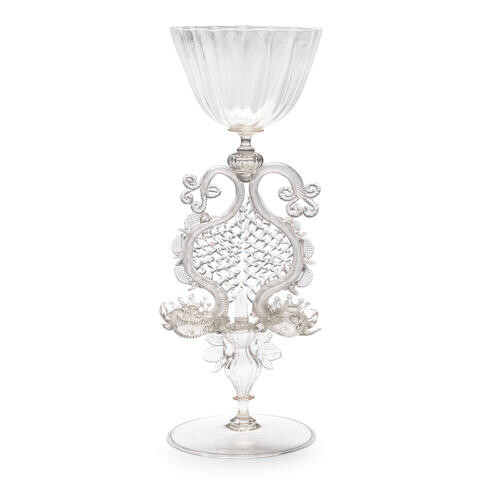An exceptionally rare façon de Venise serpent-stemmed wine glass, probably Southern Bohemia, 17th century
Possibly from the Count of Buquoy glassworks, the cup-shaped bowl moulded with fifteen evenly spaced vertical flutes, resting above a merese above a short plain section and ribbed hollow knop, the stem elaborately formed of two opposing twisted wrythen tubes of glass coiled at the tops, the bulbous ends applied with spiked ornament and resembling the heads of mythical beasts, with finely pincered 'wings' on either side, the openwork centre with a delicate traforato design of thin twisted vertical threads in clear glass, over a ribbed hollow baluster knop further applied with pincered ornament, above a short plain section between collars and a wide conical foot neatly folded at the rim, 33.5cm high
Provenance
Private British Collection
The construction of the present goblet, particularly the form of the ribbed hollow knops, closely relates to façon de Venise glasses produced in Southern Bohemia during the 17th century which have zoomorphic and serpent-like stems. Production records from the mid-17th century for the Buquoy glass factory at the Nové Hardy estate near Dobrá Voda (Heilbrunn) in particular, which was established in 1623 by Hans Walkhunni, show that they were producing a number of luxury glass items in Venetian style, most likely influenced by glass produced in the Franco-Flemish region. The most expensive of these glasses included winged and serpent-stemmed goblets.
Two goblets of remarkably similar construction in the Museum of Decorative Arts in Prague are illustrated by Olga Drahotová, 'Identifying Glass from the Buquoy Glass Factory', Journal of Glass Studies, vol.23 (1981), pp.47 and 55, fig.1. The openwork trellis stem of the present glass perhaps draws its influence from glass bowls and baskets produced in Southern Bohemia around the same time (see Drahotová (1981), p.51, fig.5), which no doubt later influenced the later products of Flemish-French and Bohemian glassmakers in Liège and elsewhere.
No other surviving goblet with a comparable openwork stem would appear to be recorded, but a remarkably similar glass appears in a 17th century German still life painting sold by Dorotheum on 30 April 2019, lot 560 and later by Sotheby's as circle of Georg Hinz on 8 April 2021, lot 323. The German attributions would perhaps support a Southern Bohemian origin. A related wine glass in the Museo Galileo (inv. no.341/33) is illustrated by Giovanni Mariacher, Italian Blown Glass (1961), pl.XXVIII. See also the goblet with an owl stem formed from a ribbed knop of similar baluster form in the British Museum (inv. no.S.461), illustrated by Hugh Tait, The Golden Age of Venetian Glass (1979), pp.62-3, no.77. Another goblet attributed to the Buquoy glassworks is in Corning Museum of Glass (inv. no.91.3.36).
View it on
Sale price
Estimate
Time, Location
Auction House
Possibly from the Count of Buquoy glassworks, the cup-shaped bowl moulded with fifteen evenly spaced vertical flutes, resting above a merese above a short plain section and ribbed hollow knop, the stem elaborately formed of two opposing twisted wrythen tubes of glass coiled at the tops, the bulbous ends applied with spiked ornament and resembling the heads of mythical beasts, with finely pincered 'wings' on either side, the openwork centre with a delicate traforato design of thin twisted vertical threads in clear glass, over a ribbed hollow baluster knop further applied with pincered ornament, above a short plain section between collars and a wide conical foot neatly folded at the rim, 33.5cm high
Provenance
Private British Collection
The construction of the present goblet, particularly the form of the ribbed hollow knops, closely relates to façon de Venise glasses produced in Southern Bohemia during the 17th century which have zoomorphic and serpent-like stems. Production records from the mid-17th century for the Buquoy glass factory at the Nové Hardy estate near Dobrá Voda (Heilbrunn) in particular, which was established in 1623 by Hans Walkhunni, show that they were producing a number of luxury glass items in Venetian style, most likely influenced by glass produced in the Franco-Flemish region. The most expensive of these glasses included winged and serpent-stemmed goblets.
Two goblets of remarkably similar construction in the Museum of Decorative Arts in Prague are illustrated by Olga Drahotová, 'Identifying Glass from the Buquoy Glass Factory', Journal of Glass Studies, vol.23 (1981), pp.47 and 55, fig.1. The openwork trellis stem of the present glass perhaps draws its influence from glass bowls and baskets produced in Southern Bohemia around the same time (see Drahotová (1981), p.51, fig.5), which no doubt later influenced the later products of Flemish-French and Bohemian glassmakers in Liège and elsewhere.
No other surviving goblet with a comparable openwork stem would appear to be recorded, but a remarkably similar glass appears in a 17th century German still life painting sold by Dorotheum on 30 April 2019, lot 560 and later by Sotheby's as circle of Georg Hinz on 8 April 2021, lot 323. The German attributions would perhaps support a Southern Bohemian origin. A related wine glass in the Museo Galileo (inv. no.341/33) is illustrated by Giovanni Mariacher, Italian Blown Glass (1961), pl.XXVIII. See also the goblet with an owl stem formed from a ribbed knop of similar baluster form in the British Museum (inv. no.S.461), illustrated by Hugh Tait, The Golden Age of Venetian Glass (1979), pp.62-3, no.77. Another goblet attributed to the Buquoy glassworks is in Corning Museum of Glass (inv. no.91.3.36).



